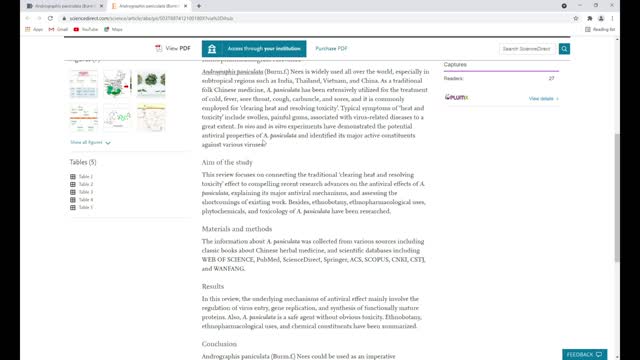Premium Only Content

Andrographis paniculata - confers anti-viral effects in vivo & in vitro
Andrographis paniculata - confers anti-viral effects in vivo & in vitro
Andrographis paniculata (Burm.f.) Nees and its major constituent andrographolide as potential antiviral agents. J Ethnopharmacol 2021 May 23;272:113954. doi: 10.1016/j.jep.2021.113954. Epub 2021 Feb 18.
Maoyuan Jiang 1, Feiya Sheng 2, Zhen Zhang 3, Xiao Ma 4, Tianhui Gao 5, Chaomei Fu 6, Peng Li 7
Affiliations collapse
Affiliations
State Key Laboratory of Quality Research in Chinese Medicine, Institute of Chinese Medical Sciences, University of Macau, Macao, 999078, China
Ethnopharmacological relevance: Andrographis paniculata (Burm.f.) Nees is widely used all over the world, especially in subtropical regions such as India, Thailand, Vietnam, and China. As a traditional folk Chinese medicine, A. paniculata has been extensively utilized for the treatment of cold, fever, sore throat, cough, carbuncle, and sores, and it is commonly employed for 'clearing heat and resolving toxicity'. Typical symptoms of 'heat and toxicity' include swollen, painful gums, associated with virus-related diseases to a great extent. In vivo and in vitro experiments have demonstrated the potential antiviral properties of A. paniculata and identified its major active constituents against various viruses.
Aim of the study: This review focuses on connecting the traditional 'clearing heat and resolving toxicity' effect to compelling recent research advances on the antiviral effects of A. paniculata, explaining its major antiviral mechanisms, and assessing the shortcomings of existing work. Besides, ethnobotany, ethnopharmacological uses, phytochemicals, and toxicology of A. paniculata have been researched.
Materials and methods: The information about A. paniculata was collected from various sources including classic books about Chinese herbal medicine, and scientific databases including WEB OF SCIENCE, PubMed, ScienceDirect, Springer, ACS, SCOPUS, CNKI, CSTJ, and WANFANG.
Results: In this review, the underlying mechanisms of antiviral effect mainly involve the regulation of virus entry, gene replication, and synthesis of functionally mature proteins. Also, A. paniculata is a safe agent without obvious toxicity. Ethnobotany, ethnopharmacological uses, and chemical constituents have been summarized.
Conclusion: Andrographis paniculata (Burm.f.) Nees could be used as an imperative complementary medicine for the treatment of diverse virus infection, efforts should be made to gain insights into its antiviral properties.
-
 LIVE
LIVE
Grant Stinchfield
1 hour agoPfizer Marketing Data Reveals 1223 Deaths in Just 10 Weeks Following COVID Vax Rollout
384 watching -
 LIVE
LIVE
The Shannon Joy Show
4 hours ago🔥🔥How’d America End up UPSIDE SIDE DOWN in China? And What Can We Do About it?🔥🔥
1,361 watching -
 DVR
DVR
Bannons War Room
18 hours agoWarRoom Live
219K45 -
 2:58:51
2:58:51
Wendy Bell Radio
8 hours agoCHECKMATE
87.6K69 -
 56:32
56:32
VSiNLive
2 hours ago $1.41 earnedA Numbers Game with Gill Alexander | Hour 1
30.8K -
 2:06:29
2:06:29
Matt Kohrs
12 hours agoPumping To New Highs, Memecoin Mania & The Week Ahead || The MK Show
43.4K2 -
 42:05
42:05
BonginoReport
6 hours agoPothole Pete Blames Plane Crash in Canada on Trump (Ep.142) - 02/18/2025
108K202 -
 1:13:40
1:13:40
Graham Allen
5 hours agoDOGE Is Going After The IRS!! Mass Firing Soon!! + ANOTHER Plane Crash! We Are Not Safe…
86K37 -
 56:28
56:28
Randi Hipper
3 hours agoArgentina's Meme Coin Disaster: Inside the LIBRA Crash
38.1K1 -
 DVR
DVR
Chicks On The Right
6 hours agoCrazy plane crash, crazy lib protests, and Deborah Birx can suck it
72.4K6